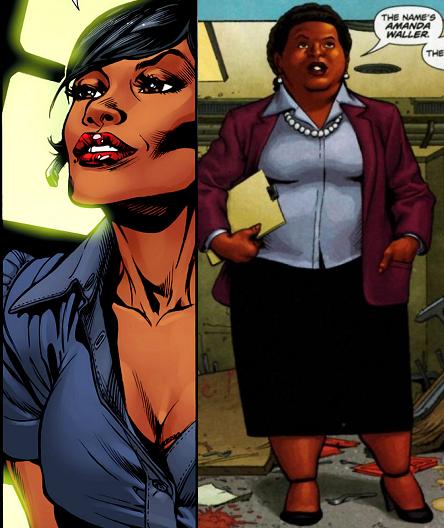
What made the original Suicide Squad series not just a good, but an excellent series can be summed up in two words: Amanda Waller. Here you had an ordinary, middle aged, somewhat overweight woman who could dominate a room full of supervillains, who had a vision of what she wanted the ‘squad to be and was ruthless in the pursuit of her goals, with an inner nobility but who never stopped being the amoral political hack she started out as, never turned into yet another pseudohero. She was a character you’d either loved or hated and many readers of suicide Squad came back month after month to hate her. In short, she was one of the most fully realised, three dimensional characters in any comic — and now she seems to have been replaced by some sort of bimbo with shirt unbuttoned, tits trust out and fifty kilos lighter..
Seems, because the woman on the last page of the first issue of the new Suicide Squad is never quite introduced as the Wall and it could all be a switcheroo. But I don’t think so. It fits in with the mentality that turns the wheelchair bound Oracle (another Suicide Squad creation) back into Batgirl, losing one of DC’s few disabled heroes, or that puts Harvey Quinn into fetish gear or –less seriously but just as dumb — let’s Floyd “Deadshot” Lawton lose his moustache. It’s change for the sake of it, where it’s not needed, going for some lowest common denominator idea of cool, just like all those stupid costume changes in Justice League.
The rest of this first issue of Suicide Squad is not much better, as it’s basically a long torture scene interrupted by flashbacks that’s ultimately revealed to be a danger room session, a test by the ‘squad’s backers to see who’d stay loyal. It’s only in the last three pages that the Squad go on their first mission, to kill 60,000 people in a football stadium. Why? No idea yet, but so far it all reads like a Hollywood idea of what a government conspiracy would look like, all very over the top. What misses is the original series sense of realism, where of course you are dealing with a world in which there are superheroes and supervillains and alien invasions and magic is real and all that, but the way John Ostrander and Kim Yale handled the idea of how the American government would use an undercover squad of supervillains worked. This however is just one big action movie cliche.